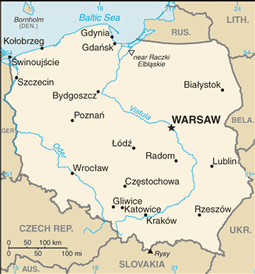Poland
 Poland is country of Europe located in central Europe.
Poland is country of Europe located in central Europe.
Details
| Official Name: | Republic of Poland |
| Capital: | Warsaw |
| Total area: | 312 679 km2 |
| GDP per capita: | $21,000 |
| Native Language: | Polish |
| Government: | Parliamentary republic |
| Population: | 38,186,860 |
| Major Religion: | Roman Catholicism |
| Monetary Unit: | Złoty (PLN) |
The north of Poland, stretching to the Baltic Sea, consists almost entirely of lowlands, while the Carpathian Mountains (including the Tatra range) form the southern border. The Masuria region forms the largest and most-visited lake district in Poland.
The Polish state is over 1 000 years old. In the 16th century Poland was one of the most powerful countries in Europe. With victory at the Battle of Vienna in 1683, King Jan III Sobieski of Poland was able to break the Ottoman siege of Vienna and end the threat of a possible occupation of western Europe.
Poland is rich in natural mineral resources, including iron, zinc, copper and rock salt. The Wieliczka salt mine, constructed in the 13th century, contains an entire town below ground with a sanatorium, theatre, church and café! Everything from stairs to chandeliers is made from salt.
Poland’s current constitution dates from 1997. The President is elected by popular vote for a five-year term. The 460 members of the lower house of parliament (the Sejm) and the 100 members of the senate, are directly elected by a system of proportional representation to serve four-year terms.
Poland’s traditional dishes include beetroot soup, cabbage rolls (cabbage leaves stuffed with meat and rice) and pierogi (dumplings stuffed with cabbage and mushrooms, for example).
Famous Poles include the astronomer Copernicus, the composer Chopin, the scientist Maria Curie-Sklodowska, film-makers Roman Polanski and Krzysztof Kieslowski, and the late Pope, John-Paul II.
Health & Welfare
Benefits provided are pensions, disability payments, child allowances, survivor benefits, maternity benefits, funeral subsidies, sickness compensation, and alimony payments.
Economy & Jobs
Agriculture, forestry, fishing, mining, and manufacturing.
Main Attractions
Warsaw, Great Masurian Lakes, Krakow city, and Tatras alpine range.
Economy
Poland's high-income economy is considered to be one of the healthiest of the post-Communist countries and is currently one of the fastest growing within the EU. Having a strong domestic market, low private debt, flexible currency, and not being dependent on a single export sector, Poland is the only European economy to have avoided the late-2000s recession. Since the fall of the communist government, Poland has steadfastly pursued a policy of liberalising the economy and today stands out as a successful example of the transition from a centrally planned economy to a primarily market-based economy. In 2009 Poland had the highest GDP growth in the EU. As of February 2012, the Polish economy has not entered a recession in the wake of the global financial crisis.
The privatization of small and medium state-owned companies and a liberal law on establishing new firms have allowed the development of an aggressive private sector. As a consequence, consumer rights organizations have also appeared. Restructuring and privatisation of "sensitive sectors" such as coal, steel, rail transport and energy has been continuing since 1990. Between 2007 and 2010, the government plans to float twenty public companies on the Warsaw Stock Exchange, including parts of the coal industry. The biggest privatisations have been the sale of the national telecoms firm Telekomunikacja Polska to France Télécom in 2000, and an issue of 30% of the shares in Poland's largest bank, PKO Bank Polski, on the Polish stockmarket in 2004.
Immigration possibilities
If you are interested in immigration to Poland, click here, and also get acquainted with the relevant migration documents.